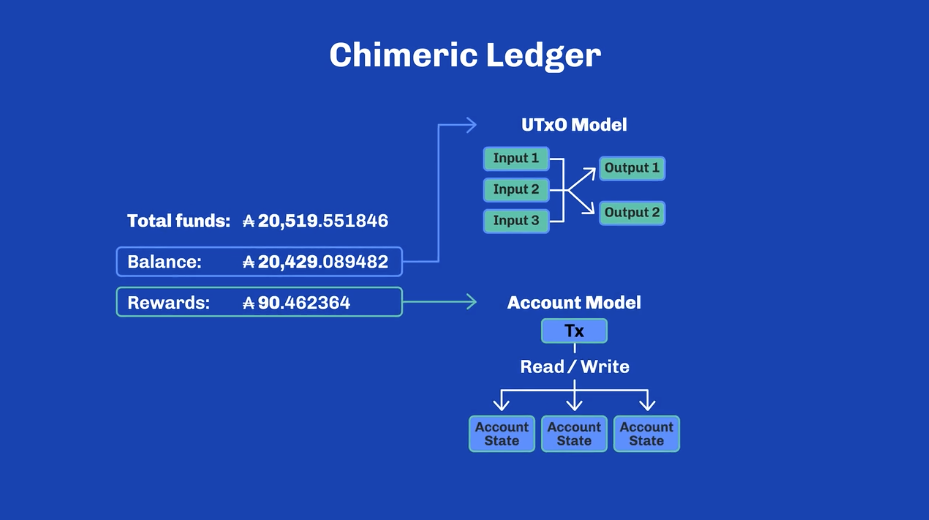A Chimeric Ledger refers to a hybrid ledger that allows a blockchain to manage both native tokens (like ADA in Cardano) and custom tokens or assets within the same system. This concept allows for a flexible, multi-asset ledger where various assets can coexist and interact on the blockchain without needing specialized, separate infrastructures for each type of token.

How Does the Chimeric Ledger Work?
In a Chimeric Ledger, both native and non-native tokens are treated similarly, meaning they can be handled, transferred, and interacted with in a unified manner. This is a key feature in Cardano, where the ledger allows users to issue and transact with custom tokens (like stablecoins, NFTs, or other digital assets) directly on the blockchain, alongside ADA.
Unlike other blockchain platforms like Ethereum, which require smart contracts to manage tokens (e.g., ERC-20 for fungible tokens or ERC-721 for NFTs), Cardano’s Chimeric Ledger natively supports multiple types of tokens. This removes the need for smart contracts for basic token operations, reducing the complexity, costs, and risks of errors associated with smart contract execution.
Chimeric Ledger in Relation to Cardano
Cardano’s multi-asset ledger is built using the concept of a Chimeric Ledger. This allows Cardano to handle:
- Native Tokens: ADA, which is the cryptocurrency of the Cardano network.
- Custom Tokens: User-created assets, which can be fungible (like other cryptocurrencies) or non-fungible (like NFTs). These are supported natively by the ledger without needing smart contracts.
This design allows Cardano to manage both ADA and custom tokens efficiently within the same system, providing benefits such as lower transaction fees and greater security, since custom tokens are managed directly by the ledger instead of by smart contracts.
Features of the Chimeric Ledger on Cardano
- Native Asset Support: Both ADA and other user-defined assets are treated as “native” assets, which can be transferred and stored in the same way.
- Lower Costs: Since no smart contracts are needed for handling custom tokens, users avoid the high gas fees typically seen in other blockchains like Ethereum.
- Increased Security: Direct ledger support for custom tokens reduces the risk of vulnerabilities that can arise from faulty or malicious smart contracts.
Summary
Purpose:
A Chimeric Ledger allows a blockchain to manage both native and custom tokens seamlessly within the same system, without the need for smart contracts to handle custom assets.
Key Function:
In Cardano, the Chimeric Ledger enables users to create, store, and transfer ADA alongside custom tokens natively on the blockchain, offering flexibility, lower transaction costs, and enhanced security.
Simplest Explanation:
A Chimeric Ledger lets a blockchain manage both its main cryptocurrency (like ADA) and other tokens (like NFTs or stablecoins) in a single system, making it easier and cheaper to use.
By using a Chimeric Ledger, Cardano offers a more efficient, secure, and cost-effective way to manage a variety of digital assets on the blockchain without relying on smart contracts for basic token functionality.
FAQs about Chimeric Ledger and Cardano
1. What is a Chimeric Ledger?
A Chimeric Ledger is a system that allows a blockchain to manage both native assets (like ADA) and custom tokens in a unified manner without needing separate infrastructures or smart contracts.
2. How does the Chimeric Ledger work on Cardano?
Cardano’s Chimeric Ledger allows users to create, store, and transfer both ADA and custom tokens natively on the blockchain, ensuring all assets are treated equally and securely within the system.
3. What are the benefits of a Chimeric Ledger?
The main benefits include:
- Lower transaction fees since custom tokens don’t require smart contracts for management.
- Increased security, as tokens are managed directly by the ledger, reducing risks from smart contract vulnerabilities.
- Flexibility in creating and managing custom assets alongside the native ADA cryptocurrency.
4. Do I need a smart contract to create tokens on Cardano?
No, Cardano’s Chimeric Ledger natively supports the creation and management of custom tokens, meaning you do not need smart contracts for basic operations like issuing or transferring tokens.
5. How is Cardano’s Chimeric Ledger different from Ethereum’s token system?
Unlike Ethereum, which requires smart contracts (like ERC-20 or ERC-721) to manage tokens, Cardano’s Chimeric Ledger allows custom tokens to be treated as first-class citizens natively on the blockchain, reducing costs and risks.
6. Can I store both ADA and custom tokens in the same wallet?
Yes, because of the Chimeric Ledger, ADA and other custom tokens can be stored and managed within the same wallet, simplifying asset management for users.

Leave a Reply